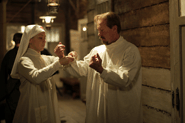 Accident, 2009. Part caper film and part psychological thriller, Soi Cheang’s Accident is an early highlight in this year’s Film Comment Selects program. Opening to the gruesome image of a fatal car accident scene, the film immediately recalibrates the viewer’s expectation over the notion of accident in another seemingly random traffic-related episode as an impatient driver, blocked by a woman in a disabled vehicle (Michelle Ye), tries to navigate around a narrow street. A fishmonger (Suet Lam) swerves past and splashes the car, occluding the driver’s view. An advertising banner collapses. An old street peddler (Shui-Fan Fung) looks on and absentmindedly discards his cigarette holder along with his spent cigarette. Before the series of events is over, the driver would lie mortally wounded on a street corner waiting for an ambulance that arrives too late. And curiously, an onlooker (Louis Koo) subsequently retrieves the discarded cigarette holder from the street. Their actions prove to be interrelated, pieces of an elaborately planned assassination of a local triad boss by a band of contract killers led by a ringleader, Ho Kwok-fai – known as “The Brain” – who, in his grief and meticulous attention to detail, is convinced that his wife’s death, too, had been orchestrated. Staging one accident after another, the group has become a surrogate family to the still haunted Ho, a bond that is strained when the team plots the death of a wheelchair-bound shopkeeper. Evoking Francis Ford Coppola’s The Conversation and Claude Chabrol’s L’Enfer in its themes of obsession and paranoia, Accident is a taut, clever, and engaging film that, like its haunted antihero, finds art in coincidence and intrigue in the mundane.
Accident, 2009. Part caper film and part psychological thriller, Soi Cheang’s Accident is an early highlight in this year’s Film Comment Selects program. Opening to the gruesome image of a fatal car accident scene, the film immediately recalibrates the viewer’s expectation over the notion of accident in another seemingly random traffic-related episode as an impatient driver, blocked by a woman in a disabled vehicle (Michelle Ye), tries to navigate around a narrow street. A fishmonger (Suet Lam) swerves past and splashes the car, occluding the driver’s view. An advertising banner collapses. An old street peddler (Shui-Fan Fung) looks on and absentmindedly discards his cigarette holder along with his spent cigarette. Before the series of events is over, the driver would lie mortally wounded on a street corner waiting for an ambulance that arrives too late. And curiously, an onlooker (Louis Koo) subsequently retrieves the discarded cigarette holder from the street. Their actions prove to be interrelated, pieces of an elaborately planned assassination of a local triad boss by a band of contract killers led by a ringleader, Ho Kwok-fai – known as “The Brain” – who, in his grief and meticulous attention to detail, is convinced that his wife’s death, too, had been orchestrated. Staging one accident after another, the group has become a surrogate family to the still haunted Ho, a bond that is strained when the team plots the death of a wheelchair-bound shopkeeper. Evoking Francis Ford Coppola’s The Conversation and Claude Chabrol’s L’Enfer in its themes of obsession and paranoia, Accident is a taut, clever, and engaging film that, like its haunted antihero, finds art in coincidence and intrigue in the mundane.
 Nucingen House, 2008. Structured as a tale within a tale, Raoul Ruiz’s fractured, defiantly illogical Nucingen House returns to the territory of On Top of the Whale and its otherworldly, tongue in cheek sense of foreboding in its hermetic construction of polyglot characters, suspended time, and inescapable limbo. Unfolding as a reconstructed memory told by an American gambler, Will James (Jean-Marc Barr) upon overhearing a nearby dinner conversation discussing – rather imprecisely – a third hand account of the strange events that James and his fragile wife, Anne Marie (Elsa Zylberstein) had encountered years earlier during their stay at a remote estate called Nucingen House, the film incorporates familiar Ruizian elements of mnemonic devices, dark humor, and repetition in its loopy tale of haunting and possession. Having arrived at Patagonia to claim property that he had won in a bet and facilitate Anne Marie’s recuperation, the unwitting couple is soon introduced to the household’s idiosyncratic rules (one that relegates certain languages and religion to peripheral areas of the house) and equally eccentric family – an insomniac housemaid (Miriam Heard) who seems to exist in a perpetual state of waking dream, an indifferent patriarch (Laurent Malet) who refuses to leave but cannot pay rent, a young man who seems constantly pressed for time (Thomas Durand), a flirtatious young woman (Laure de Clermont-Tonnerre) who continues to mourn the loss of her best friend, Léonore (Audrey Marnay), and a perennial houseguest [and family physician (Luis Mora)] prone to taking cat naps at the dinner table. Ever straddling the line between highbrow and camp, Nucingen House ultimately suffers from a broader schism, where atmosphere is counteracted by the starkness of video, and any cultural allegory on modern day Chile is tempered by a reinforcing self-awareness of its construction.
Nucingen House, 2008. Structured as a tale within a tale, Raoul Ruiz’s fractured, defiantly illogical Nucingen House returns to the territory of On Top of the Whale and its otherworldly, tongue in cheek sense of foreboding in its hermetic construction of polyglot characters, suspended time, and inescapable limbo. Unfolding as a reconstructed memory told by an American gambler, Will James (Jean-Marc Barr) upon overhearing a nearby dinner conversation discussing – rather imprecisely – a third hand account of the strange events that James and his fragile wife, Anne Marie (Elsa Zylberstein) had encountered years earlier during their stay at a remote estate called Nucingen House, the film incorporates familiar Ruizian elements of mnemonic devices, dark humor, and repetition in its loopy tale of haunting and possession. Having arrived at Patagonia to claim property that he had won in a bet and facilitate Anne Marie’s recuperation, the unwitting couple is soon introduced to the household’s idiosyncratic rules (one that relegates certain languages and religion to peripheral areas of the house) and equally eccentric family – an insomniac housemaid (Miriam Heard) who seems to exist in a perpetual state of waking dream, an indifferent patriarch (Laurent Malet) who refuses to leave but cannot pay rent, a young man who seems constantly pressed for time (Thomas Durand), a flirtatious young woman (Laure de Clermont-Tonnerre) who continues to mourn the loss of her best friend, Léonore (Audrey Marnay), and a perennial houseguest [and family physician (Luis Mora)] prone to taking cat naps at the dinner table. Ever straddling the line between highbrow and camp, Nucingen House ultimately suffers from a broader schism, where atmosphere is counteracted by the starkness of video, and any cultural allegory on modern day Chile is tempered by a reinforcing self-awareness of its construction.
 Perfect Life, 2008. Composed as parallel narratives on the status of women in the capitalist-fueled, rapidly expanding economy of contemporary China – one, a fictional account of Li Yueying (Yao Qianyu), a working class young woman and her search for a better life; the other, a documentary on Jenny, a middle-class housewife and mother undergoing a divorce – Emily Tang’s A Perfect Life follows in the vein of Wang Bing and Jia Zhangke in presenting a cultural portrait of the “other” China. Estranged from her parents, disconnected from her coddled, slacker brother, and drifting from one low paying job to another as she chases after job opportunities, Yueying’s story is, in a way, a metaphor for China itself in her rootlessness, ambition, and facility for constant reinvention (During the course of the film, Li appears as an aspiring performer, prosthetic factory worker, hotel maid, flight attendant impostor, bride, shopkeeper, and lover). Similarly, Jenny’s story embodies the insecurity and disempowerment that comes with profound cultural transformation. Compelled to re-enter the workplace after her increasingly messy divorce, her gradual slide into poverty is implied in her constant job hunting and in the milieu of her interviews that shift from a comfortable Hong Kong apartment to a rented dormitory bunk bed near a dance hall. By capturing a seemingly mundane encounter between the two women at Yueying’s shop (Tang ingeniously keeps Yueying out of frame until Jenny leaves the store to maintain the narrative distinction), Tang insightfully reflects on their interconnected destinies – a dissolution of the bounds between reality and fiction that culminates in the image of Yueying posing with her wedding picture, figuratively rejecting and reinforcing her created image.
Perfect Life, 2008. Composed as parallel narratives on the status of women in the capitalist-fueled, rapidly expanding economy of contemporary China – one, a fictional account of Li Yueying (Yao Qianyu), a working class young woman and her search for a better life; the other, a documentary on Jenny, a middle-class housewife and mother undergoing a divorce – Emily Tang’s A Perfect Life follows in the vein of Wang Bing and Jia Zhangke in presenting a cultural portrait of the “other” China. Estranged from her parents, disconnected from her coddled, slacker brother, and drifting from one low paying job to another as she chases after job opportunities, Yueying’s story is, in a way, a metaphor for China itself in her rootlessness, ambition, and facility for constant reinvention (During the course of the film, Li appears as an aspiring performer, prosthetic factory worker, hotel maid, flight attendant impostor, bride, shopkeeper, and lover). Similarly, Jenny’s story embodies the insecurity and disempowerment that comes with profound cultural transformation. Compelled to re-enter the workplace after her increasingly messy divorce, her gradual slide into poverty is implied in her constant job hunting and in the milieu of her interviews that shift from a comfortable Hong Kong apartment to a rented dormitory bunk bed near a dance hall. By capturing a seemingly mundane encounter between the two women at Yueying’s shop (Tang ingeniously keeps Yueying out of frame until Jenny leaves the store to maintain the narrative distinction), Tang insightfully reflects on their interconnected destinies – a dissolution of the bounds between reality and fiction that culminates in the image of Yueying posing with her wedding picture, figuratively rejecting and reinforcing her created image.
 Applause, 2009. From the first images of Applause, Martin Zandvliet seeks to capture a rawness and immediacy in his complex, if familiar portrait of a recovering alcoholic. Shot in grainy, desaturated medium and close-ups with a handheld camera, a middle-aged woman (Paprika Steen), seemingly under the influence, makes a candid assessment of her relationship with her husband. A reference to their Anglicized names, George and Martha, presents an initial disconnect, and subsequent confrontations with her unseen husband recontextualizes her drunken tirade as scenes from Edward Albee’s play, Who’s Afraid of Virginia Woolf?. The interconnection – and dissociation – between reality and drama also provides the framework for the respected actress, Thea’s volatile personality. Unable to maintain a relationship since her divorce from Christian (Michael Falch), and having relinquished custody of her children to him after an alcohol-fueled act of negligence, Thea is eager to turn over a new leaf. But soon, the delineation between real-life and performance collapses for her, measuring her struggle to reconnect within the emotional arcs of a staged drama, and in the process, drifts even further away from finding some semblance of a normal life that continues to elude her. In its grittiness and intimacy, Applause recalls the spirit of John Cassavetes’s cinema, most notably, Opening Night and A Woman Under the Influence. However, it is also this association that ultimately undermines the film’s potency by framing its provocative character study of self-destruction and recovery in a generic looseleaf of conventional tropes and allusive homages.
Applause, 2009. From the first images of Applause, Martin Zandvliet seeks to capture a rawness and immediacy in his complex, if familiar portrait of a recovering alcoholic. Shot in grainy, desaturated medium and close-ups with a handheld camera, a middle-aged woman (Paprika Steen), seemingly under the influence, makes a candid assessment of her relationship with her husband. A reference to their Anglicized names, George and Martha, presents an initial disconnect, and subsequent confrontations with her unseen husband recontextualizes her drunken tirade as scenes from Edward Albee’s play, Who’s Afraid of Virginia Woolf?. The interconnection – and dissociation – between reality and drama also provides the framework for the respected actress, Thea’s volatile personality. Unable to maintain a relationship since her divorce from Christian (Michael Falch), and having relinquished custody of her children to him after an alcohol-fueled act of negligence, Thea is eager to turn over a new leaf. But soon, the delineation between real-life and performance collapses for her, measuring her struggle to reconnect within the emotional arcs of a staged drama, and in the process, drifts even further away from finding some semblance of a normal life that continues to elude her. In its grittiness and intimacy, Applause recalls the spirit of John Cassavetes’s cinema, most notably, Opening Night and A Woman Under the Influence. However, it is also this association that ultimately undermines the film’s potency by framing its provocative character study of self-destruction and recovery in a generic looseleaf of conventional tropes and allusive homages.
 Persecution, 2009. The themes explored in Patrice Chéreau’s probing, tightly constructed Persecution are prefigured in the film’s disorienting (and quintessentially Chéreau) opening sequence. Scanning from one anonymous commuter to another, a panhandler makes her way through a crowded train before someone makes inopportune eye contact, and she responds by slapping her face. The episode intrigues a bystander, Daniel (Romain Duris) and impulsively follows the shaken victim to the nearest exit, eager to uncover the non-verbal cues that had been exchanged in the moments before the heated encounter. In hindsight, this convergence of fixation, contact, rejection, and violence also consumes Daniel in his personal life. Hopping from one construction site to another working as a home remodeling contractor (which serves as his temporary residence as well), Daniel is searching for some permanence and constancy in his relationship with his distant, jet-setting girlfriend, Sonia (Charlotte Gainsbourg), but their interaction is often reduced to voice messages and chance meetings with mutual friends. Ironically, ever searching for ways to hold his Sonia’s attention, Daniel has only succeeded in capturing the interest of a lonely, middle-aged man (Jean-Hugues Anglade) who has begun to stalk him at his latest job site. Stitching together pieces of a seemingly rootless and unremarkable life as itinerant worker, nursing home volunteer, and insecure lover, Chéreau creates a lucid and provocative exposition on the ephemeral – and searing – nature of the search for human connection.
Persecution, 2009. The themes explored in Patrice Chéreau’s probing, tightly constructed Persecution are prefigured in the film’s disorienting (and quintessentially Chéreau) opening sequence. Scanning from one anonymous commuter to another, a panhandler makes her way through a crowded train before someone makes inopportune eye contact, and she responds by slapping her face. The episode intrigues a bystander, Daniel (Romain Duris) and impulsively follows the shaken victim to the nearest exit, eager to uncover the non-verbal cues that had been exchanged in the moments before the heated encounter. In hindsight, this convergence of fixation, contact, rejection, and violence also consumes Daniel in his personal life. Hopping from one construction site to another working as a home remodeling contractor (which serves as his temporary residence as well), Daniel is searching for some permanence and constancy in his relationship with his distant, jet-setting girlfriend, Sonia (Charlotte Gainsbourg), but their interaction is often reduced to voice messages and chance meetings with mutual friends. Ironically, ever searching for ways to hold his Sonia’s attention, Daniel has only succeeded in capturing the interest of a lonely, middle-aged man (Jean-Hugues Anglade) who has begun to stalk him at his latest job site. Stitching together pieces of a seemingly rootless and unremarkable life as itinerant worker, nursing home volunteer, and insecure lover, Chéreau creates a lucid and provocative exposition on the ephemeral – and searing – nature of the search for human connection.
 Kinatay, 2009. The opening sequence of Brillante Mendoza’s Kinatay provides an intriguing foil in its organic, intersecting stories that mirror the chaos of the city, as a young working class couple (and new parents) Cecille (Mercedes Cabral) and Peping (Coco Martin) make their way to city hall to get married and, along the way, encounter a news crew reporting on a potential suicide jumper. With a year left to his police academy training, Peping is eager to make a good impression on his superior officers, even helping out in their daily routine of intimidating street vendors to extort money. However, when an officer recruits him for an unspecified operation involving an exotic dancer, Peping is soon initiated into a darker world of drug dealing, prostitution, and violence, and is forced to confront his complicity in the systematic corruption. Similar to Mendoza’s previous film Serbis, Kinatay provides an illuminating, if truncated regional panorama of a contemporary Filipino city – in this case, the industrial city of Mandaluyong. Interweaving cultural landscape and moral ambiguity, the film finds kinship with Orso Miret’s Le Silence in its well-intentioned, but ultimately impotent social critique. Indeed, by abruptly shifting from the organic approach of the opening sequence to a distilled, linear (if not myopic) perspective that dominates the rest of the film (except for a tire changing scene near the conclusion), Mendoza oddly supplants his fascinating and detailed cultural observation with a far more conventional psychological portrait of guilt, and in the process, creates a sense of indirection not unlike the dilemma faced by his indecisive protagonist.
Kinatay, 2009. The opening sequence of Brillante Mendoza’s Kinatay provides an intriguing foil in its organic, intersecting stories that mirror the chaos of the city, as a young working class couple (and new parents) Cecille (Mercedes Cabral) and Peping (Coco Martin) make their way to city hall to get married and, along the way, encounter a news crew reporting on a potential suicide jumper. With a year left to his police academy training, Peping is eager to make a good impression on his superior officers, even helping out in their daily routine of intimidating street vendors to extort money. However, when an officer recruits him for an unspecified operation involving an exotic dancer, Peping is soon initiated into a darker world of drug dealing, prostitution, and violence, and is forced to confront his complicity in the systematic corruption. Similar to Mendoza’s previous film Serbis, Kinatay provides an illuminating, if truncated regional panorama of a contemporary Filipino city – in this case, the industrial city of Mandaluyong. Interweaving cultural landscape and moral ambiguity, the film finds kinship with Orso Miret’s Le Silence in its well-intentioned, but ultimately impotent social critique. Indeed, by abruptly shifting from the organic approach of the opening sequence to a distilled, linear (if not myopic) perspective that dominates the rest of the film (except for a tire changing scene near the conclusion), Mendoza oddly supplants his fascinating and detailed cultural observation with a far more conventional psychological portrait of guilt, and in the process, creates a sense of indirection not unlike the dilemma faced by his indecisive protagonist.
 Land of Madness, 2009. In its idiosyncratic, tongue-in-cheek mixture of documentary, self-confessional, and deconstruction, Land of Madness is a droll and refreshing throwback to Luc Moullet’s early essay films like Anatomy of a Relationship and Origins of a Meal. Returning to his bucolic, ancestral hometown in the Southern Alps, Moullet embarks on a whimsical, homegrown investigation of the region’s disproportionally high rate of mental illness. Proposing that this geographical hotbed forms a pentagonal “land of madness” – one that, for some unknown reason, has an inactive center that, like the eye of a hurricane, defies the phenomenon – Moullet suggests some suspect pathologies, perhaps mutations caused by a Chernobyl-styled irradiation, or behavioral adaptation to a medical affliction, such as a prevalence of goiter that would have invariably led to a culture of “slowness”. Moullet then expounds on his theory by presenting a string of bizarre crimes that have occurred over the past century at the vertex towns – some motivated by passion, theft, or revenge, others remaining unsolved mysteries. As in his earlier essays, Moullet concludes with an intersection of personal experience and social observation that recontextualizes the basis of the argument and leads to further debate (with his wife, Antonietta Pizzorno) – in this case, a harbored family grief over a relative who had committed a senseless murder.
Land of Madness, 2009. In its idiosyncratic, tongue-in-cheek mixture of documentary, self-confessional, and deconstruction, Land of Madness is a droll and refreshing throwback to Luc Moullet’s early essay films like Anatomy of a Relationship and Origins of a Meal. Returning to his bucolic, ancestral hometown in the Southern Alps, Moullet embarks on a whimsical, homegrown investigation of the region’s disproportionally high rate of mental illness. Proposing that this geographical hotbed forms a pentagonal “land of madness” – one that, for some unknown reason, has an inactive center that, like the eye of a hurricane, defies the phenomenon – Moullet suggests some suspect pathologies, perhaps mutations caused by a Chernobyl-styled irradiation, or behavioral adaptation to a medical affliction, such as a prevalence of goiter that would have invariably led to a culture of “slowness”. Moullet then expounds on his theory by presenting a string of bizarre crimes that have occurred over the past century at the vertex towns – some motivated by passion, theft, or revenge, others remaining unsolved mysteries. As in his earlier essays, Moullet concludes with an intersection of personal experience and social observation that recontextualizes the basis of the argument and leads to further debate (with his wife, Antonietta Pizzorno) – in this case, a harbored family grief over a relative who had committed a senseless murder.
 Air Doll, 2009. During a poignant encounter in Hirokazu Kore-eda’s idiosyncratic, yet droll and resonant contemporary fable, a reclusive doll maker, Sonoda (Jô Odagiri) tells a troubled inflatable doll turned video store clerk, Nozomi (Du-na Bae) that the main difference between her and a human being is biodegradability. In a way, Sonoda’s simplified differentiation between burnable and nonburnable trash captures the essence of Air Doll as well, exploring not only socially reductive gender roles, but also the meaning of being human in a culture of technology, mass production, and consumption that substitutes connection for instant gratification. At its most basic is Nozomi’s role as a sexual surrogate for her owner, Hideo (Itsuji Itao) who, despite naming her after a former girlfriend, prefers to avoid the emotional entanglements of a real-life relationship. Another is her misdirected attempt at goodwill towards an insecure receptionist that alludes to the problems of aging in a youth-obsessed society, having been increasingly marginalized at work, replaced by her younger coworker. Another is her friendship with an elderly man who relies on a portable breathing apparatus for survival, recasting the notion of the human body as a network of biological functions within the modern reality of artificial life support systems. Another surrogacy emerges in the brooding Junichi’s (Arata) fetishistic attraction towards her, implied in his continued obsession (and perhaps guilt) over a lost love. It is this recurring convergence of organic and synthetic, structure and plasticity throughout the film that is also reflected in the bookending image of a young woman awakening to find beauty in the mundane, a transitory affirmation of humanity in the face of obsolescence and disposability.
Air Doll, 2009. During a poignant encounter in Hirokazu Kore-eda’s idiosyncratic, yet droll and resonant contemporary fable, a reclusive doll maker, Sonoda (Jô Odagiri) tells a troubled inflatable doll turned video store clerk, Nozomi (Du-na Bae) that the main difference between her and a human being is biodegradability. In a way, Sonoda’s simplified differentiation between burnable and nonburnable trash captures the essence of Air Doll as well, exploring not only socially reductive gender roles, but also the meaning of being human in a culture of technology, mass production, and consumption that substitutes connection for instant gratification. At its most basic is Nozomi’s role as a sexual surrogate for her owner, Hideo (Itsuji Itao) who, despite naming her after a former girlfriend, prefers to avoid the emotional entanglements of a real-life relationship. Another is her misdirected attempt at goodwill towards an insecure receptionist that alludes to the problems of aging in a youth-obsessed society, having been increasingly marginalized at work, replaced by her younger coworker. Another is her friendship with an elderly man who relies on a portable breathing apparatus for survival, recasting the notion of the human body as a network of biological functions within the modern reality of artificial life support systems. Another surrogacy emerges in the brooding Junichi’s (Arata) fetishistic attraction towards her, implied in his continued obsession (and perhaps guilt) over a lost love. It is this recurring convergence of organic and synthetic, structure and plasticity throughout the film that is also reflected in the bookending image of a young woman awakening to find beauty in the mundane, a transitory affirmation of humanity in the face of obsolescence and disposability.
 Morphia, 2009. Adapted from Mikhail Bulgakov’s collection of autofictional stories, A Country Doctor’s Notebook, Aleksei Balabanov’s Morphia is an unvarnished portrait of rural Russia at the cusp of the Bolshevik Revolution. Told from the perspective of an idealistic young doctor, Polyakov (Leonid Bichevin), Morphia retains the humor and texturality of Bulgakov’s prose to underscore Polyakov’s difficult and overwhelming adjustment to the isolation of life in the country where he has moved to serve as the region’s only physician. Still uncertain over his medical skills (often running back from the clinic to his nearby study in order to review textbooks on the medical procedures that he is about to perform) and struggling to cope with the backwardness of the community that often endanger his patients (in one episode, the parents of a girl suffering from acute asphyxia refuse to consent to an emergency tracheotomy, arguing that such a procedure would cause certain death), Polyakov finds unexpected respite in a morphine injection that had been administered by head nurse, Anna Nicolaevna (Ingeborga Dapkunaite) to treat an allergic reaction. However, as the demands of his job continue to mount, Polyakov’s dependence soon turns into full-blown addiction, leading him to increasingly desperate and reckless acts when a war-driven medical rationing threatens to cut off his supply. By emphasizing the intersection of personal and national history, Balabanov not only captures the social conditions that enabled the revolution, but also establishes Polyakov’s obsession and paranoia within the context of his seemingly more altruistic efforts to educate the rural community, not unlike the agitprop trains that toured the countryside to spread the gospel of the revolution (note that Polyakov is first seen arriving by train). In essence, by correlating Polyakov’s self-destruction with his idealism, Morphia also serves as a pointed allegory for the dysfunction that ultimately led to the collapse of the Soviet Union – a tragicomic denouement to a noble social experiment that, like the film’s flawed, well-intentioned hero, had lost its way.
Morphia, 2009. Adapted from Mikhail Bulgakov’s collection of autofictional stories, A Country Doctor’s Notebook, Aleksei Balabanov’s Morphia is an unvarnished portrait of rural Russia at the cusp of the Bolshevik Revolution. Told from the perspective of an idealistic young doctor, Polyakov (Leonid Bichevin), Morphia retains the humor and texturality of Bulgakov’s prose to underscore Polyakov’s difficult and overwhelming adjustment to the isolation of life in the country where he has moved to serve as the region’s only physician. Still uncertain over his medical skills (often running back from the clinic to his nearby study in order to review textbooks on the medical procedures that he is about to perform) and struggling to cope with the backwardness of the community that often endanger his patients (in one episode, the parents of a girl suffering from acute asphyxia refuse to consent to an emergency tracheotomy, arguing that such a procedure would cause certain death), Polyakov finds unexpected respite in a morphine injection that had been administered by head nurse, Anna Nicolaevna (Ingeborga Dapkunaite) to treat an allergic reaction. However, as the demands of his job continue to mount, Polyakov’s dependence soon turns into full-blown addiction, leading him to increasingly desperate and reckless acts when a war-driven medical rationing threatens to cut off his supply. By emphasizing the intersection of personal and national history, Balabanov not only captures the social conditions that enabled the revolution, but also establishes Polyakov’s obsession and paranoia within the context of his seemingly more altruistic efforts to educate the rural community, not unlike the agitprop trains that toured the countryside to spread the gospel of the revolution (note that Polyakov is first seen arriving by train). In essence, by correlating Polyakov’s self-destruction with his idealism, Morphia also serves as a pointed allegory for the dysfunction that ultimately led to the collapse of the Soviet Union – a tragicomic denouement to a noble social experiment that, like the film’s flawed, well-intentioned hero, had lost its way.
Acquarello, 2010 [reprinted]